How we made our game in 48 hours as part of Global Game Jam 2015
Hello everyone from the Black Sea coast of Russia! My name is Alexander and I run a small cozy studio engaged in the development of mobile applications and games. Our friendly team took part in the Global Game Jam 2015, which was held from January 23 to 25, 2015 in Krasnodar. Under the cut - a story about how in two days to do what I wanted for many years.

On a warm Friday afternoon, our adventure began. We formed a strategic stock of coffee, devices and good mood and went to the regional capital, Krasnodar, to be at the coworking center CO-Place - the venue for GGJ'15 by 17 o'clock. GGJ is an annual worldwide hackathon where teams create various games for 48 hours in non-stop mode. Then the projects are presented to the local audience and put on the network so that anyone can download and run the game.
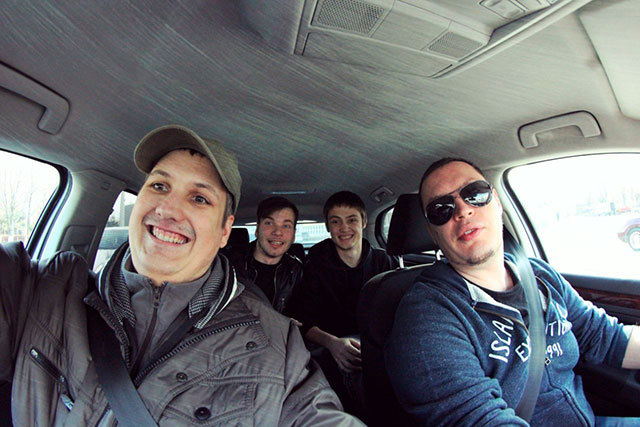
Upon arrival at coworking, we laid out our devices and waited for the announcement of the topic. Every year the GGJ organizers publish the topic on which the game should be created - as a rule, an abstract theme is chosen, only defining the course - but in no way limiting the flight of fancy. Along with the main theme, additional subtopics are announced, something like achivok, for example: playing with only one button (Stephen Hawking can play this) or playing with folk elements.
')
A few words about our team CASE-Mobile. We were a solid, friendly team in which I was the project manager and responsible for the sound. Igor and Egor - cool code in Unity 3D, and Tma polished the gameplay and tested the prototypes. In the co-working we were joined by the artist and animator Max, who helped us a lot - almost all the graphics were drawn by him. UI / UX designer Cyril, who drew the interface and splash screen, helped us remotely.
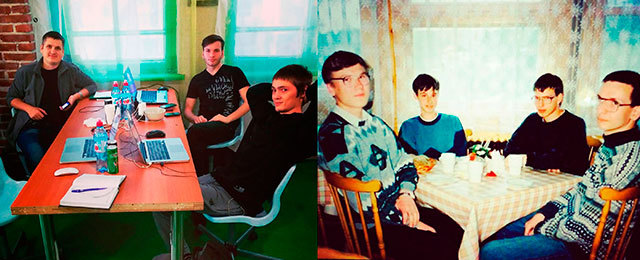
At 19 o'clock the hackathon participants gathered in the visual zone in anticipation of the announcement of the topic. We were presented with a twenty-minute video in which several people expounded their understanding of the modern gaming industry, problems and current Western social foundations. Sexual and sexual equality, racial discrimination, etc., etc., etc. ... After the prelude, a theme was announced that this year sounded like "What do we do now?" The hall plunged into deathly silence. “How can this be called a topic?” - the first reaction of one of the participants. Well, it was not necessary to choose, and we proceeded to the Brainsturm.
After 20 minutes of heated discussion, we had the following ideas:

As a result, we stopped at the fourth version. Neighbors seemed to us the most pleasant in the development of gameplay and real - in time. An important argument “for” was that the concept of the game is quite simple and at the same time implies high replayability. It is connected with the touchscreen, and since we specialize in games for mobile devices, we are used to working with it.
After the announcement of the project themes (a total of 5 were announced), the participants started creating their own games ...
Teams are immersed in the magical process of creating a game. We jointly finished the concept of the game, and then gave it to Tyome to work out the gameplay. After that, I started organizing the workflow, Max began to draw the first sketches, and Igor and Egor launched Unity with a resharper and began to prepare the scene and the scripts.

A few hours later, a dizdok was ready with a description of the gameplay, characters and all the key features of the game. Thus, we had: 10 characters with passive / active / file animation / behavior mode, the house in which they appear, unique tapas and swipes for each of the characters, a scoring system, and sounds of all actions and objects.

The final gameplay looked like this: rooms with neighbors appear randomly in the house. The neighbor in each room is unique, he has a certain action, which he continuously performs. If he is not helped by the specified gesture, then the neighbor comes to the fail state and the game ends. The whole difficulty lies in the fact that the number of neighbors is constantly increasing - the player needs to keep a lot of objects in sight and not let the neighbors fail. Lasted longer - got more points. After losing, the cycle repeats, until the player is satisfied with his result or until he just gets bored.
Initially, we planned to introduce logical connections between neighbors (for example, the repairman closed the wires and left another neighbor without electricity), but due to tight deadlines, we abandoned this idea. They also reduced the number of neighbors in the house from 10 to 6, which made it comfortable to play on the tablet and tolerably on a large smartphone. It was a competent assessment of their capabilities that allowed us to pass the game on time.
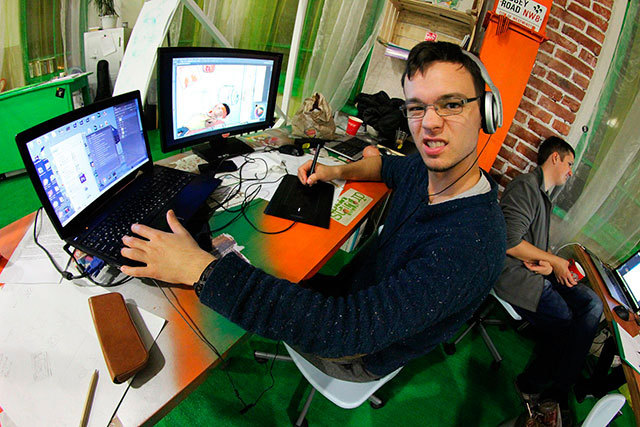
It was dusk outside the window, the winter day was faintly elusive, but the work was not interrupted for a second. Each team member was busy with his own business. So, 5 hours after the announcement of the topic, we had the first prototype prepared, prepared by Igor, conjuring with gestures on the wheelbarrow.

The prototype was a blue screen in which 6 red rectangles were located. By making a unique tap or svayp on a rectangle, he changed his color. After a few more hours, the prototype was ready with stripes-indicators of the state of the neighbor. And closer to 3 o'clock in the morning, Max finished all 6 rooms and we went to bed.
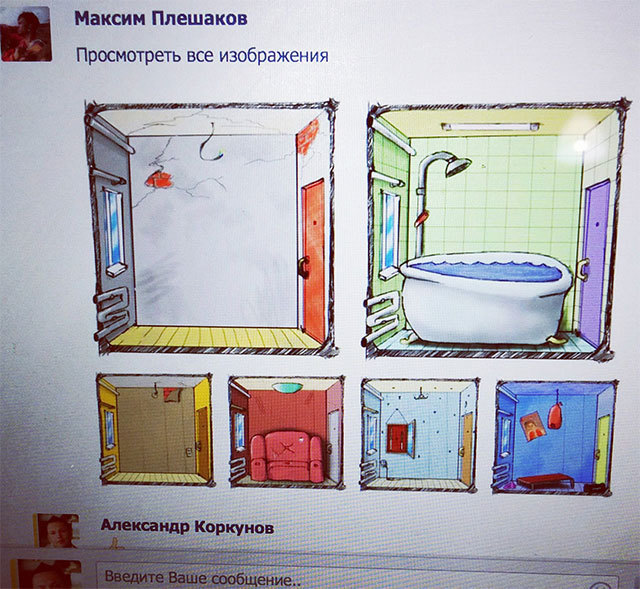
Good morning does not happen, and at 8:00 the whole team got to the alarm clock. Gradually regaining consciousness, we continued to work on the game. Towards noon, Yegor prepared the main stage and camera, and Max drew and animated the first character - the programmer.
A little bit about the characters. There are six of them: the programmer types on the keyboard, the blonde takes a bath, the cat scratches the sofa, the puncher drills the wall, the athlete presses from the chest, the alcoholic (what would you think?) Drinks vodka. Each character has a passive state - when the player does not pay attention to the neighbor, and active - when the player helps the neighbor. If a neighbor fails, a funny screensaver, unique to each character, is shown. The characters came out funny and lively, a bit like our team. An alcoholic, for example, looks away from Tyoma.
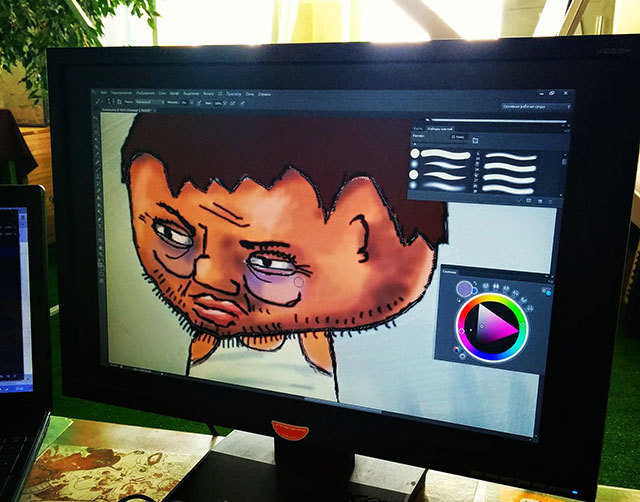
On Saturday there were quite a few people in co-working, apparently everyone went home. Since we were not supposed to go abroad, the cozy CO-Place became our second home for 48 hours. In the intervals between the process, we played Kendama, which Artyom brought, rested on soft sofas. Later, the girl Max came to us, who next door participated in the stage shooting and was therefore in an original costume. After some time, we learned that her parish was captured in a live broadcast, and this led to the local meme “suddenly, a fairy visited us.” By the way, the whole hackathon was constantly broadcast on the Internet, where you can still watch everything in the recording.
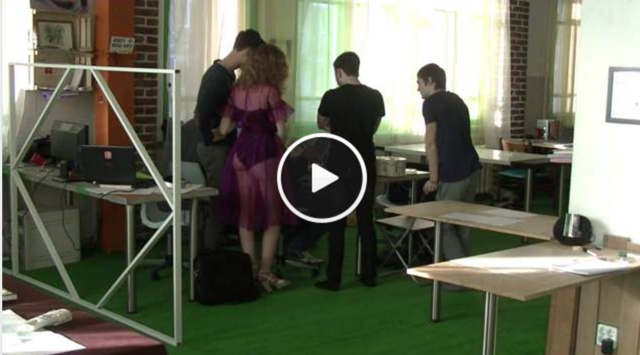
It was getting dark. Each of us was aware of the proximity of the appropriate deadline, while the forces were already running out. We were terribly stupid - emotional and physical fatigue let us know - but we continued to work on the game. Sleep is for wimps! Deep at night, all the characters with animations were ready and integrated into the game. The prototype looked almost like a release version. Satisfied, but terribly tired, we went to bed, anticipating tomorrow's final.
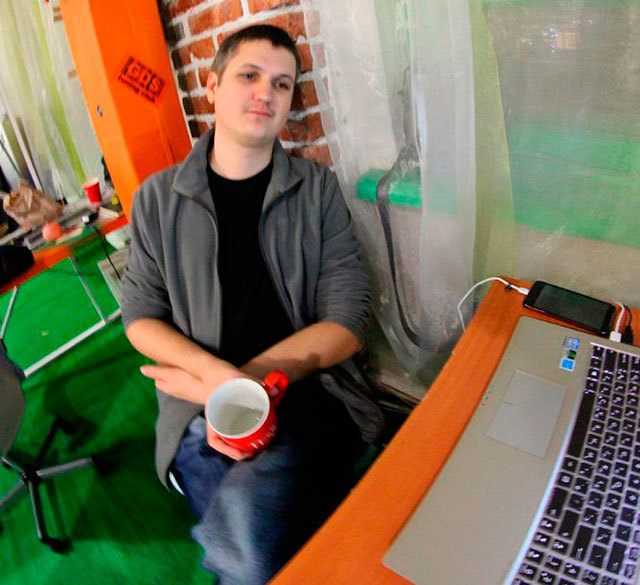
Early in the morning we were woken up by the alarm clock of Stanislav, the host of coworking. A few infinitely long minutes of shrill ringing could activate the remnants of our internal reserves. Of course, there was little strength left. We were given a glass look and vague speech. A couple of cups of coffee gave us an invigorating buff for several hours, for which we completed the graphics, polished the gameplay. A few more hours (alas! Buffs are a short-lived thing) it took to embed the interface and points system.

By 15 Moscow the game was completely ready. We called it Roomie - “roommate”, it seems to sound cool. Software development, as I mentioned earlier, was conducted on Unity 3D, which allowed us to make a fully functional multi-platform project in a short time. Android was chosen as the main platform, since it is much easier to distribute your game, without hemorrhoids with supplies, UDIDs, and other complications. Gulf project on the site globalgamejam.org, we waited for the final and the presentation of projects in our coworking.

4 of 5 announced projects were ready for the final. The number of people in coworking has increased significantly, everyone came to look at the project presentations. Our presentation was the second in a row and was delayed by a small hitch related to the broadcast of the Android screen picture on TV. During the presentation, we talked about our game: how the idea of the game was born and how it was implemented from scratch in 48 hours. A working version of the game on an Android tablet was shown, as well as a prototype on an iPad. Among all the projects, our game was the most playable and looked like the final product, and not as a demo or an initial prototype. Of course, the result is far from ideal, but for version 1.0 it is pretty decent.
After the presentations, we, mostly co-working, went to the nearest bar, where we exchanged our impressions and ideas on the past hackathon. Global Game Jam is a real class event that unites people with a passion for computer games. After some time, we said goodbye to everyone and went to our home, successfully completing our adventure.
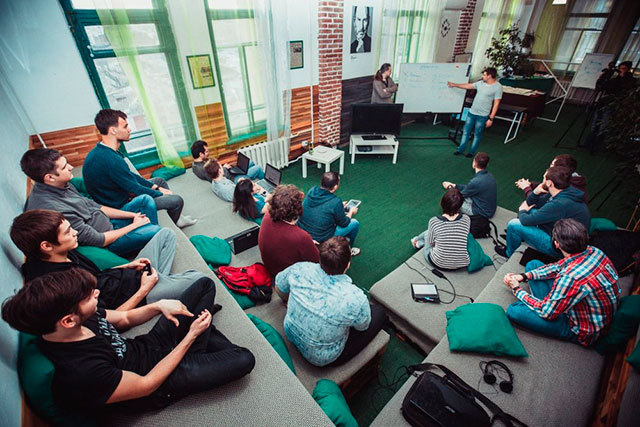
In conclusion, I would like to add the following. If you have always dreamed of creating your own game - Global Game Jam is an excellent reason for this. With minimal knowledge and abilities, everyone can participate in the process of creating a game, and with some assistance from Mrs. Fortuna and the coffee maker, bring the project to a finished look. Designer, programmer, tester, writer, illustrator, ideological mastermind is not important. Just come to GGJ - and make your dream come true. A dream to create games!
Some friendly advice to future GGJ members, which I hope will be added after reading my article. Although many people say that the beauty of the hackathon in the randomness of the formed teams, I believe that if you want to achieve a result, namely to create a full-fledged game, you should participate in a close-knit team who have minimal experience in joint development. If you are a loner - it does not matter: look for ready-made teams whose ideas seem most interesting to you. You must be mentally prepared for the 48 hours of the marathon and not throw everything halfway through. Critical thinking at the initial stage and a rational development strategy are key to victory. Act according to the rule: first a minimum, and then - what we have time, and you will succeed. Dare!
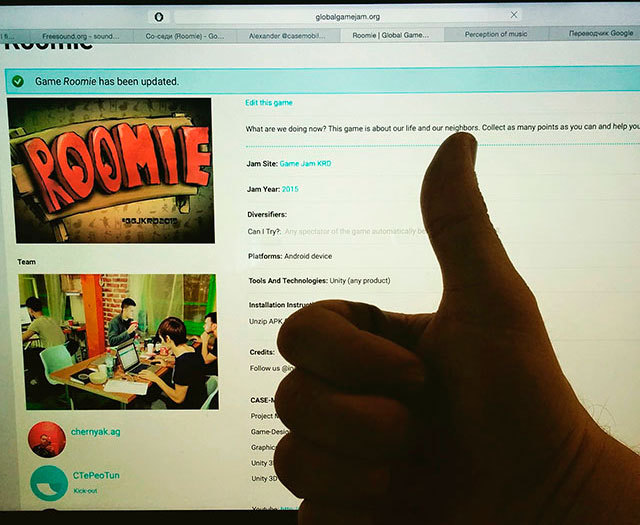
PS In total, more than 3300 projects were registered at Global Game Jam 2015, 2000 of which were created on Unity 3D. Almost 30 projects were submitted from Russia.

On a warm Friday afternoon, our adventure began. We formed a strategic stock of coffee, devices and good mood and went to the regional capital, Krasnodar, to be at the coworking center CO-Place - the venue for GGJ'15 by 17 o'clock. GGJ is an annual worldwide hackathon where teams create various games for 48 hours in non-stop mode. Then the projects are presented to the local audience and put on the network so that anyone can download and run the game.

We had four beach packages, 8 cans of adrenaline, 3 packages of cookies, 4 liters of juice and a full salon of various devices. As well as a cake. Not that it was the necessary reserve for the trip, but once we went to the store, it would be difficult to stop.
Upon arrival at coworking, we laid out our devices and waited for the announcement of the topic. Every year the GGJ organizers publish the topic on which the game should be created - as a rule, an abstract theme is chosen, only defining the course - but in no way limiting the flight of fancy. Along with the main theme, additional subtopics are announced, something like achivok, for example: playing with only one button (Stephen Hawking can play this) or playing with folk elements.
')
A few words about our team CASE-Mobile. We were a solid, friendly team in which I was the project manager and responsible for the sound. Igor and Egor - cool code in Unity 3D, and Tma polished the gameplay and tested the prototypes. In the co-working we were joined by the artist and animator Max, who helped us a lot - almost all the graphics were drawn by him. UI / UX designer Cyril, who drew the interface and splash screen, helped us remotely.

Waiting for the topic. All matches in the photo are random.
At 19 o'clock the hackathon participants gathered in the visual zone in anticipation of the announcement of the topic. We were presented with a twenty-minute video in which several people expounded their understanding of the modern gaming industry, problems and current Western social foundations. Sexual and sexual equality, racial discrimination, etc., etc., etc. ... After the prelude, a theme was announced that this year sounded like "What do we do now?" The hall plunged into deathly silence. “How can this be called a topic?” - the first reaction of one of the participants. Well, it was not necessary to choose, and we proceeded to the Brainsturm.
After 20 minutes of heated discussion, we had the following ideas:
- A ball of people (We say “NO” to drugs!) Is a platformer. The ball rolls on people, gathers a society. The ball needs to overcome obstacles in the form of wars and bubonic plague.
- Create an emotion - logic. The emotion is depicted on the screen, the player’s task to create it from the available objects (for example, on the screen of the knife and flower images. If emotion is suffering, you need to move the knife to the flower).
- Now and in the future - logic, arcade. The screen is divided into two parts: in one everything happens in the present tense, the other in the future.
- Neighbors - in the house there are neighbors who need to help tapami and svaypami to solve domestic problems.

List of ideas after brainstorming.
As a result, we stopped at the fourth version. Neighbors seemed to us the most pleasant in the development of gameplay and real - in time. An important argument “for” was that the concept of the game is quite simple and at the same time implies high replayability. It is connected with the touchscreen, and since we specialize in games for mobile devices, we are used to working with it.
After the announcement of the project themes (a total of 5 were announced), the participants started creating their own games ...
Teams are immersed in the magical process of creating a game. We jointly finished the concept of the game, and then gave it to Tyome to work out the gameplay. After that, I started organizing the workflow, Max began to draw the first sketches, and Igor and Egor launched Unity with a resharper and began to prepare the scene and the scripts.

The first sketches of characters.
A few hours later, a dizdok was ready with a description of the gameplay, characters and all the key features of the game. Thus, we had: 10 characters with passive / active / file animation / behavior mode, the house in which they appear, unique tapas and swipes for each of the characters, a scoring system, and sounds of all actions and objects.

Design paper is ready.
The final gameplay looked like this: rooms with neighbors appear randomly in the house. The neighbor in each room is unique, he has a certain action, which he continuously performs. If he is not helped by the specified gesture, then the neighbor comes to the fail state and the game ends. The whole difficulty lies in the fact that the number of neighbors is constantly increasing - the player needs to keep a lot of objects in sight and not let the neighbors fail. Lasted longer - got more points. After losing, the cycle repeats, until the player is satisfied with his result or until he just gets bored.
Initially, we planned to introduce logical connections between neighbors (for example, the repairman closed the wires and left another neighbor without electricity), but due to tight deadlines, we abandoned this idea. They also reduced the number of neighbors in the house from 10 to 6, which made it comfortable to play on the tablet and tolerably on a large smartphone. It was a competent assessment of their capabilities that allowed us to pass the game on time.

Our artist Max - in a creative impulse.
It was dusk outside the window, the winter day was faintly elusive, but the work was not interrupted for a second. Each team member was busy with his own business. So, 5 hours after the announcement of the topic, we had the first prototype prepared, prepared by Igor, conjuring with gestures on the wheelbarrow.

We try the gameplay on the prototype.
The prototype was a blue screen in which 6 red rectangles were located. By making a unique tap or svayp on a rectangle, he changed his color. After a few more hours, the prototype was ready with stripes-indicators of the state of the neighbor. And closer to 3 o'clock in the morning, Max finished all 6 rooms and we went to bed.

Six rooms are almost ready!
Good morning does not happen, and at 8:00 the whole team got to the alarm clock. Gradually regaining consciousness, we continued to work on the game. Towards noon, Yegor prepared the main stage and camera, and Max drew and animated the first character - the programmer.
A little bit about the characters. There are six of them: the programmer types on the keyboard, the blonde takes a bath, the cat scratches the sofa, the puncher drills the wall, the athlete presses from the chest, the alcoholic (what would you think?) Drinks vodka. Each character has a passive state - when the player does not pay attention to the neighbor, and active - when the player helps the neighbor. If a neighbor fails, a funny screensaver, unique to each character, is shown. The characters came out funny and lively, a bit like our team. An alcoholic, for example, looks away from Tyoma.

Concept drunkard.
On Saturday there were quite a few people in co-working, apparently everyone went home. Since we were not supposed to go abroad, the cozy CO-Place became our second home for 48 hours. In the intervals between the process, we played Kendama, which Artyom brought, rested on soft sofas. Later, the girl Max came to us, who next door participated in the stage shooting and was therefore in an original costume. After some time, we learned that her parish was captured in a live broadcast, and this led to the local meme “suddenly, a fairy visited us.” By the way, the whole hackathon was constantly broadcast on the Internet, where you can still watch everything in the recording.

Suddenly, a fairy visited us.
It was getting dark. Each of us was aware of the proximity of the appropriate deadline, while the forces were already running out. We were terribly stupid - emotional and physical fatigue let us know - but we continued to work on the game. Sleep is for wimps! Deep at night, all the characters with animations were ready and integrated into the game. The prototype looked almost like a release version. Satisfied, but terribly tired, we went to bed, anticipating tomorrow's final.

Igor after the first 30 hours of coding.
Early in the morning we were woken up by the alarm clock of Stanislav, the host of coworking. A few infinitely long minutes of shrill ringing could activate the remnants of our internal reserves. Of course, there was little strength left. We were given a glass look and vague speech. A couple of cups of coffee gave us an invigorating buff for several hours, for which we completed the graphics, polished the gameplay. A few more hours (alas! Buffs are a short-lived thing) it took to embed the interface and points system.

Roomie on gold!
By 15 Moscow the game was completely ready. We called it Roomie - “roommate”, it seems to sound cool. Software development, as I mentioned earlier, was conducted on Unity 3D, which allowed us to make a fully functional multi-platform project in a short time. Android was chosen as the main platform, since it is much easier to distribute your game, without hemorrhoids with supplies, UDIDs, and other complications. Gulf project on the site globalgamejam.org, we waited for the final and the presentation of projects in our coworking.

48 hours of work behind. Max, me, Egor, Igor and Tyoma.
4 of 5 announced projects were ready for the final. The number of people in coworking has increased significantly, everyone came to look at the project presentations. Our presentation was the second in a row and was delayed by a small hitch related to the broadcast of the Android screen picture on TV. During the presentation, we talked about our game: how the idea of the game was born and how it was implemented from scratch in 48 hours. A working version of the game on an Android tablet was shown, as well as a prototype on an iPad. Among all the projects, our game was the most playable and looked like the final product, and not as a demo or an initial prototype. Of course, the result is far from ideal, but for version 1.0 it is pretty decent.
After the presentations, we, mostly co-working, went to the nearest bar, where we exchanged our impressions and ideas on the past hackathon. Global Game Jam is a real class event that unites people with a passion for computer games. After some time, we said goodbye to everyone and went to our home, successfully completing our adventure.

Presentation of projects.
In conclusion, I would like to add the following. If you have always dreamed of creating your own game - Global Game Jam is an excellent reason for this. With minimal knowledge and abilities, everyone can participate in the process of creating a game, and with some assistance from Mrs. Fortuna and the coffee maker, bring the project to a finished look. Designer, programmer, tester, writer, illustrator, ideological mastermind is not important. Just come to GGJ - and make your dream come true. A dream to create games!
Some friendly advice to future GGJ members, which I hope will be added after reading my article. Although many people say that the beauty of the hackathon in the randomness of the formed teams, I believe that if you want to achieve a result, namely to create a full-fledged game, you should participate in a close-knit team who have minimal experience in joint development. If you are a loner - it does not matter: look for ready-made teams whose ideas seem most interesting to you. You must be mentally prepared for the 48 hours of the marathon and not throw everything halfway through. Critical thinking at the initial stage and a rational development strategy are key to victory. Act according to the rule: first a minimum, and then - what we have time, and you will succeed. Dare!

The Roomie page at globalgamejam.org.
PS In total, more than 3300 projects were registered at Global Game Jam 2015, 2000 of which were created on Unity 3D. Almost 30 projects were submitted from Russia.
Source: https://habr.com/ru/post/249329/
All Articles